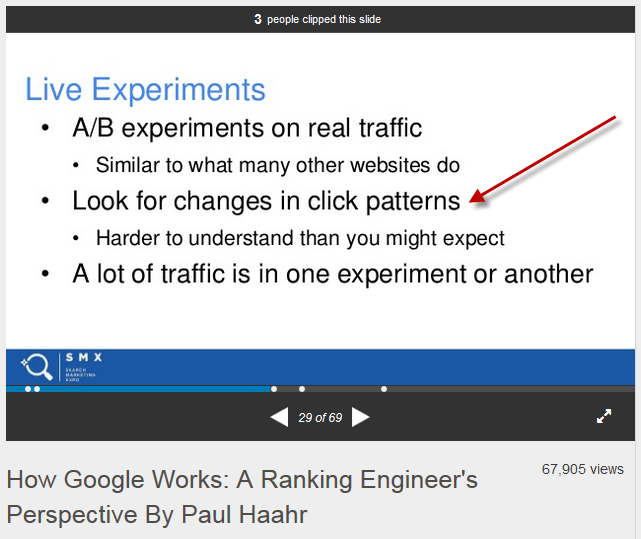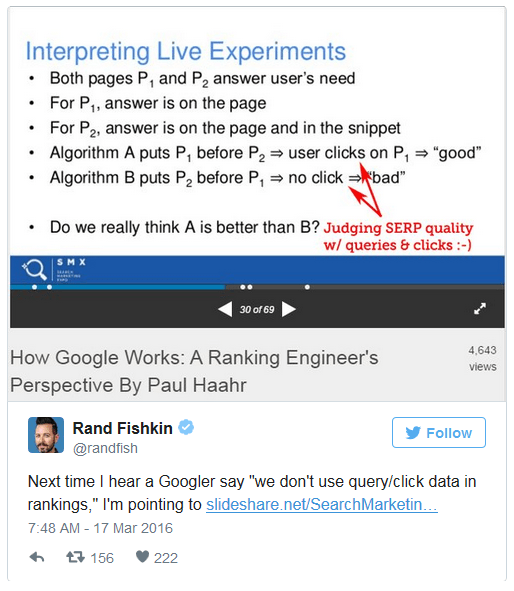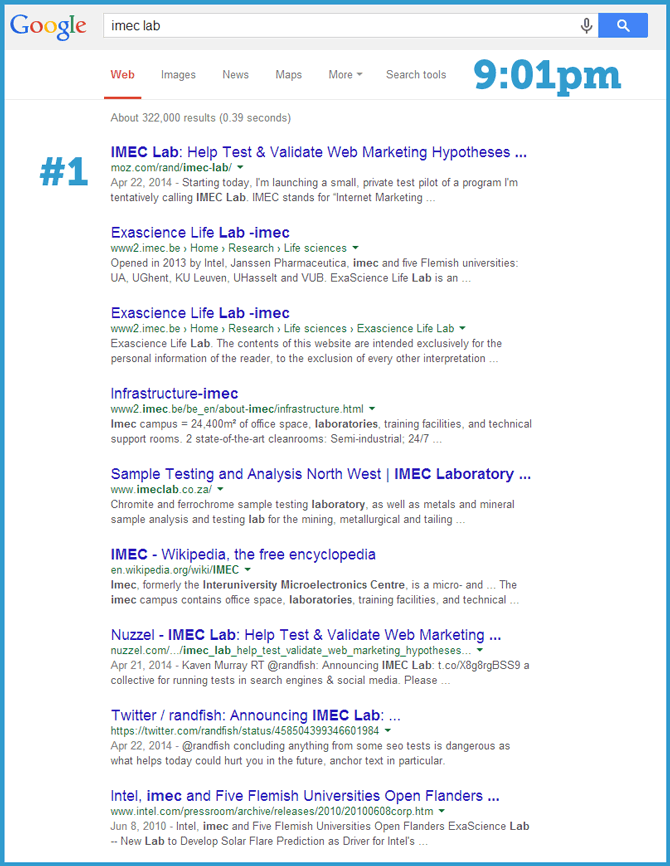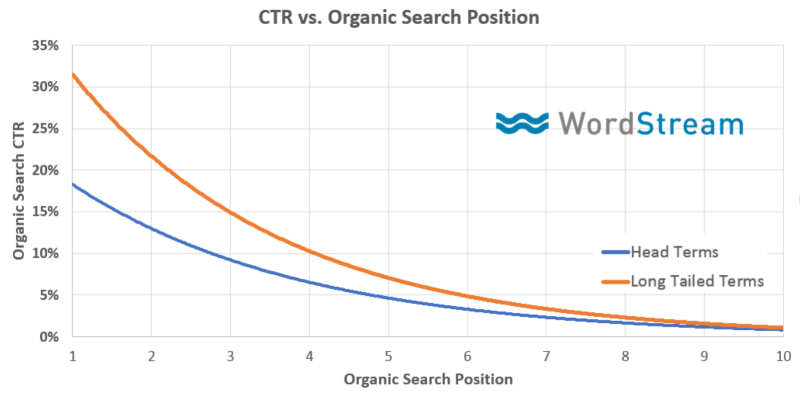
Does organic click-through rate (CTR) data impact page rankings on Google? This has been a huge topic of speculation for years within the search industry.
Why is there such a debate? Well, often people get hung up on details and semantics (are we talking about a direct or indirect ranking factor?), Google patents (which may or may not even be in use), and competing theories (everyone’s got an opinion based off something they heard or read). To make matters more confusing, Google is less than forthcoming about the secrets of their algorithm.
But if CTR truly does impact Google’s organic search rankings, shouldn’t we be able to measure it? Yes!
In this post, I’ll share some intriguing data on the relationship between Google CTR and rankings. I’ll also share four tips for making sure your Google click-through rates on the organic SERPs are where they need to be.
To be clear: my goal with this post is to provide just a brief background and some actionable insights about the topic of organic click-through rates on Google. We won’t dissect every tweet or quote ever made by anyone at Google, dive deep into patents, or refute all the SEO theories about whether CTR is or isn’t a ranking factor. I’m sharing my own theory based on what I’ve seen, and my recommendations on how to act on it.
Google CTR & Rankings: Yes! No! Who Bloody Knows!
Eric Enge of Stone Temple Consulting recently published a post with a headline stating that CTR isn’t a ranking factor. He clarifies within that post that Google doesn’t use CTR as a direct ranking factor.
What’s the difference between a direct and indirect ranking factor? Well, I suggest you watch Rand Fishkin’s awesome video on this very topic.
Basically, we know certain things directly impact rankings (I got a link from a reputable website, hooray!), but there are many other things that don’t have a direct impact, but nevertheless do impact ranking (some big-time influencer tweeted about my company and now tons of people are searching for us and checking out our site, awesome!).
It’s essentially the same issue as last touch attribution, which assigns all the credit to the last interaction. But in reality, multiple channels (PPC, organic, social, email, affiliates, etc.) can play important roles in the path to conversion.
The same is true with ranking. Many factors influence ranking.
So here’s my response: Direct, indirect, who cares? CTR might not be a “direct core ranking signal,” but if it impacts rank (and I believe it does), then it matters. Further, even if it doesn’t impact rank, you should still care!
But don’t take my word for it that Google has the technology. Check out these slides from Google engineer Paul Haahr, who spoke at SMX:
Also, AJ Kohn put together a good post about Google click-through rate as a ranking signal last year. He included a couple eye-opening quotes that I’ll share here because they are important. The first from Edmond Lau, a former Google engineer:
“It’s pretty clear that any reasonable search engine would use click data on their own results to feed back into ranking to improve the quality of search results. Infrequently clicked results should drop toward the bottom because they’re less relevant, and frequently clicked results bubble toward the top. Building a feedback loop is a fairly obvious step forward in quality for both search and recommendations systems, and a smart search engine would incorporate the data.”
The second from Marissa Mayer in 2007 talking about how Google used CTR as a way to determine when to display a OneBox:
“We hold them to a very high click-through rate expectation and if they don’t meet that click-through rate, the OneBox gets turned off on that particular query. We have an automated system that looks at click-through rates per OneBox presentation per query. So it might be that news is performing really well on Bush today but it’s not performing very well on another term, it ultimately gets turned off due to lack of click-through rates. We are authorizing it in a way that’s scalable and does a pretty good job enforcing relevance.”
Also, check out this amazing excerpt from an FTC document that was obtained by the WSJ:
“In addition, click data (the website links on which a user actually clicks) is important for evaluating the quality of the search results page. As Google’s former chief of search quality Udi Manber testified:
The ranking itself is affected by the click data. If we discover that, for a particular query, hypothetically, 80 percent of people click on Result No. 2 and only 10 percent click on Result No. 1, after a while we figure out, well, probably Result 2 is the one people want. So we’ll switch it.
Testimony from Sergey Brin and Eric Schmidt confirms that click data is important for many purposes, including, most importantly, providing ‘feedback’ on whether Google’s search algorithms are offering its users high quality results.”
Why Organic Google CTR Matters
If you have great positions in the SERPs, that’s awesome. But even high rankings don’t guarantee visits to your site.
What really matters is how many people are clicking on your listing (and not bouncing back immediately). You want to attract more visitors who are likely to stick around and then convert.
In 2009, the head of Google’s webspam team at the time, Matt Cutts, was asked about the importance of maximizing your organic CTR. Here’s a key quote that says it all:
“It doesn’t really matter how often you show up. It matters how often you get clicked on and then how often you … convert those to whatever you really want (sales, purchases, subscriptions)… Do spend some time looking at your title, your URL, and your snippet that Google generates, and see if you can find ways to improve that and make it better for users because then they’re more likely to click. You’ll get more visitors, you’ll get better return on your investment.”
In another video, he talked about the importance of titles, especially on your important web pages: “you want to make something that people will actually click on when they see it in the search results – something that lets them know you’re gonna have the answer they’re looking for.”
Bottom line: Google cares a lot about overall user engagement with the results they show in the SERPs. So if Google is testing your page for relevancy to a particular keyword search, and you want that test to go your way, you better have a great CTR (and great content and great task completion rates). Otherwise, you’ll fail the quality test and someone else will get chosen.
Want to improve your CTR?
Free guide >> Tricks to get the Click: 10 Tips for Writing Better Ad Copy
Testing the Real Impact of Organic CTR on Google
Rand Fishkin conducted one of the most popular tests of the influence of CTR on Google’s search results. He asked people to do a specific search and click on the link to his blog (which was in 7th position). This impacted the rankings for a short period of time, moving the post up to 1st position.
But these are all temporary changes. The rankings don’t persist because the inflated CTR’s aren’t natural.
It’s like how you can’t increase your AdWords Quality Scores simply by clicking on your own ads a few times. This is the oldest trick in the book and it doesn’t work. (Sorry.)
Isn’t CTR Too Easy to Game?
The results of another experiment appeared on Search Engine Land last August and concluded that CTR isn’t a ranking factor. But this test had a pretty significant flaw – it relied on bots artificially inflating CTRs and search volume (and this test was only for a single two-word keyword: “negative SEO”). So essentially, this test was the organic search equivalent of click fraud.
I’ve seen a lot of people saying Google will never use CTR in organic rankings because “it’s too easy to game” or “too easy to fake.” I disagree. Google Ads (formerly known as AdWords) has been fighting click fraud for 15 years and they can easily apply these learnings to organic search. There are plenty of ways to detect unnatural clicking. What did I just say about old tricks?
Before we look at the data, a final “disclaimer.” I don’t know if what this data reveals is due to RankBrain, or another machine-learning-based ranking signal that’s already part of the core Google algorithm. Regardless, there’s something here – and I can most certainly say with confidence that CTR is impacting rank.
NEW DATA: Does Organic CTR Impact SEO Rankings?
Google has said that RankBrain is being tested on long-tail terms, which makes sense. Google wants to start testing its machine-learning system with searches they have little to no data on – and 99 percent of pages have zero external links pointing to them.
How is Google able to tell which pages should rank in these cases?
By examining engagement and relevance. CTR is one of the best indicators of both.
High-volume head terms, as far as we know, aren’t being exposed to RankBrain right now. So by observing the differences between the organic search CTRs of long-tail terms versus head terms, we should be able to spot the difference:
So here’s what we did: We looked at 1,000 keywords in the same keyword niche (to isolate external factors like Google shopping and other SERP features that can alter CTR characteristics). The keywords are all from my own website: wordstream.com.
I compared CTR versus rank for one- or two-word search terms, and did the same thing for long-tail keywords (search terms between 4 to 10 words).
Notice how the long-tail terms get much higher average CTRs for a given position. For example, in this data set, the head term in position 1 got an average CTR of 17.5 percent, whereas the long-tail term in position 1 had a remarkably high CTR, at an average of 33 percent.
You’re probably thinking: “Well, that makes sense. You’d expect long-tail terms to have stronger query intent, thus higher CTRs.” That’s true, actually.
But why is that long-tail keyword terms with high CTRs are so much more likely to be in top positions versus bottom-of-page organic positions? That’s a little weird, right?
OK, let’s do an analysis of paid search queries in the same niche. We use organic search to come up with paid search keyword ideas and vice versa, so we’re looking at the same keywords in many cases.
Long-tail terms in this same vertical get higher CTRs than head terms. However, the difference between long-tail and head term CTR is very small in positions 1–2, and becomes huge as you go out to lower positions.
So in summary, something unusual is happening:
- In paid search, long-tail and head terms do roughly the same CTR in high ad spots (1–2) and see huge differences in CTR for lower spots (3–7).
- But in organic search, the long-tail and head terms in spots 1–2 have huge differences in CTR and very little difference as you go down the page.
Why are the same keywords behaving so differently in organic versus paid?
The difference (we think) is that pages with higher organic click-through rates are getting a search ranking boost.
How to Beat the Expected Organic Search CTR
CTR and ranking are codependent variables. There’s obviously a relationship between the two, but which is causing what? In order to get to the bottom of this “chicken versus egg” situation, we’re going to have to do a bit more analysis.
The following graph takes the difference between an observed organic search CTR minus the expected CTR, to figure out if your page is beating — or being beaten by — the expected average CTR for a given organic position.
By only looking at the extent by which a keyword beats or is beaten by the predicted CTR, you are essentially isolating the natural relationship between CTR and ranking in order to get a better picture of what’s going on.
We found that, on average, if you beat the expected CTR, then you’re far more likely to rank in more prominent positions. Failing to beat the expected CTR makes it more likely you’ll appear in positions 6–10.
So, based on our example of long-tail search terms for this niche, if a page:
- Beats the expected CTR for a given position by 20 percent, you’re likely to appear in position 1.
- Beats the expected CTR for a given position by 12 percent, then you’re likely to appear in position 2.
- Falls below the expected CTR for a given position by 6 percent, then you’re likely to appear in position 10.
And so on.
Here’s a greatly simplified rule of thumb:
The more your pages beat the expected organic CTR for a given position, the more likely you are to appear in prominent organic positions.
If your pages fall below the expected organic Google search CTR, then you’ll find your pages in lower organic positions on the SERP.
Want to move up by one position in Google’s rankings? Increase your CTR by 3 percent. Want to move up another spot? Increase your CTR by another 3 percent.
If you can’t beat the expected click-through rate for a given position, you’re unlikely to appear in positions 1–5.
Essentially, you can think of all of this as though Google is giving bonus points to pages that have high click-through rates. The fact that it looks punitive is just a natural side effect.
If Google gives “high CTR bonus points” to other websites, then your relative performance will decline. It’s not that you got penalized; it’s just that you didn’t get the rewards.
4 Crucial Ways to Raise Your Google CTRs
Many “expert” SEOs will tell you not to waste time trying to maximize your CTRs since it’s supposedly “not a direct ranking signal.” “Let’s build more links and make more infographics,” they say.
I couldn’t disagree more. If you want to rank better, you need to get more people to your website. (And getting people to your website is the whole point of ranking anyway!)
Google Ads and many other technologies look at user engagement signals to determine page quality and relevance. We’ve already seen evidence that CTR is important to Google.
So how do you raise your Google CTRs – not just for a few days, but in a sustained way? You should focus your efforts in four key areas:
- Optimize pages with low “organic Quality Scores.” Download all of your query data from the Google Search Console. Sort your data, figure out which of your pages have below average CTRs, and prioritize those. Don’t risk turning one of your unicorn pages with an awesome CTR into a donkey with a terrible CTR! It’s far less risky turning a donkey into unicorn!
- Combine your SEO keywords with emotional triggers to create irresistible headlines. Emotions like anger, disgust, affirmation, and fear are proven to increase click-through rates and conversion rates. If everyone who you want to beat already has crafted optimized title tags, then packing an emotional wallop will give you the edge you need and make your listing stand out.
- Work to improve other user engagement metrics. Like click-through rate, we believe you need to have better-than-expected engagement metrics (e.g. time on site and bounce rate). This is a critical relevance signal! Google has enough data to know the expected conversion and engagement rates based on a variety of factors (e.g. industry, query, location, time of day, device type). If your content performs well, you’re likely going to get a rankings boost. If your content does poorly, there’s not necessarily a penalty, but you definitely won’t get any bonus points.
- Use social media ads and remarketing to increase search volume and CTR. Paid social ads and remarketing display ads can generate serious awareness and exposure for a reasonable cost (no more than $50 a day). If people aren’t familiar with your brand, bombard your target audience with Facebook and Twitter ads. People who are familiar with your brand are 2x more likely to click through and to convert!
Just Say No To Low Google CTRs!
You want to make sure your pages get as many organic search clicks as possible. Doing so means more people are visiting your site, which will send important signals to Google that your page is relevant and awesome.
Our research also shows that above-expected user engagement metrics result in better organic rankings, which results in even more clicks to your site (AKA organic traffic!).
Don’t settle for average CTRs. Be a unicorn in a sea of donkeys! Raise your CTRs and engagement rates! Get optimizing now!














